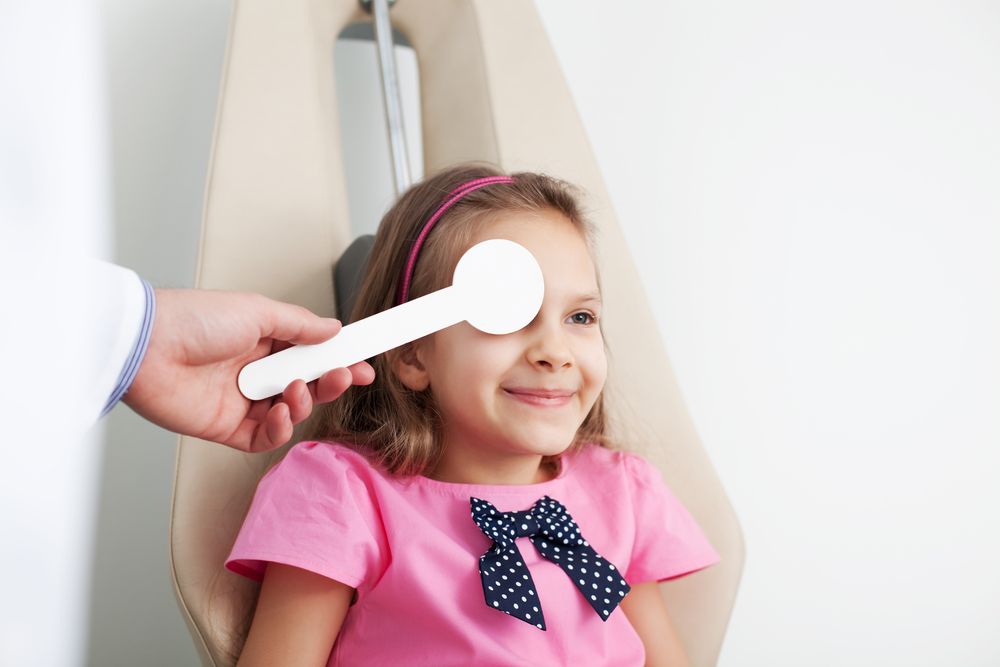
Lazy Eye
The first few years are crucial to the development of your child’s vision and there are a variety of factors which can impact the process.
Amblyopia, also known as lazy eye, is a developmental issue which affects vision in one or both eyes and usually develops before age seven.
When should I start looking for signs of a lazy eye?

Symptoms Begin to Develop at an Early Age
Blurred Vision
Since amblyopia often begins in infancy, symptoms can be hard to identify. However, if you notice your child squinting, shutting one eye, or tilting their head, they may have a vision issue. They may also fuss or cry when you cover one eye.
Poor Depth Perception
When the eyes do not work together properly, it is more difficult to judge distances. Issues with depth perception can indicate that one eye is stronger than the other.
Eye Alignment Issues
If you notice your baby or young child has crossed eyes or another apparent misalignment, schedule an eye exam immediately. Eye misalignment, or strabismus, does not always occur with amblyopia.
A Family History of Certain Eye Conditions Can Increase the Risk of Amblyopia
Anything which blurs a child’s vision can potentially cause a lazy eye. There are some factors which can increase a child’s risk of developing amblyopia, such as:
- Premature birth
- Small size at birth
- Family history
- Developmental disabilities
If you have a family history of crossed eyes, childhood cataracts, or other eye conditions, it is especially important to have your child’s eyes checked early, and often, to avoid future issues.
What can affect my child's vision?
Impairments to Clear Vision during Development Can Cause a Lazy Eye
Strabismus
When one eye crosses in or turns out, this muscle imbalance prevents the eye from focusing properly. Over time, the brain learns to ignore the out-of-focus images and rely on the other eye to compensate for lost vision.
Unequal Refractive Errors
A mismatched prescription means one eye focuses more effectively than the other. If one eye is more nearsighted, more farsighted, or has more astigmatism, amblyopia can result.
Vision Deprivation in One Eye
A variety of issues can limit clear vision in one eye, such as a clouding of the lens or a droopy eyelid. This condition, known as deprivation amblyopia, requires urgent treatment in infancy to prevent vision loss.
Treatment of amblyopia after the age of 17 is not dependent upon age, but requires more effort including vision therapy. It's been proven that a motivated adult with strabismus and/or amblyopia who works diligently at vision therapy can obtain meaningful improvement in visual function. Leonard J. Press, FAAO, FCOVD
Catching Amblyopia Early Is the Best Way to Prevent Vision Loss
Early Eye Exams
The most effective method for protecting your child’s vision from amblyopia-related vision loss is early diagnosis. Children should have their vision checked by or before their fourth birthday.
Wearing Glasses at a Young Age
If your child has a significant refractive error, such as nearsightedness, farsightedness, or astigmatism, glasses or contact lenses can prevent these conditions from interfering with proper vision development.
Removing Obstructions
Since anything blocking your child’s vision can cause developmental issues, early treatment of the obstruction can prevent a lazy eye from occurring.
A Comprehensive Eye Exam Can Detect Amblyopia
During an eye exam, your child’s eye doctor will evaluate their ocular health. The doctor will also check for any signs of wandering, a difference in vision between the eyes, or poor vision in one or both eyes. They may use eye drops to dilate the eyes which can cause blurred vision for several hours.
Eye exams are painless and should cause your child little to no distress. In most cases, you will stay in the room with your child during the exam. For very young children, the doctor may ask you to hold them on your lap to help them remain calm and still.

Your child’s age and stage of development will determine the method of diagnosis used.
Preverbal children: Your child’s doctor can use a lighted microscope to detect cataracts. They may also perform tests to assess how well your child can focus their gaze and follow a moving object.
Children three and older: The doctor will check each eye individually by using an eye patch. Tests using pictures and letters can help determine if your child’s vision is clear.
Proper Treatment Can Offer Significant Results
Eye Patches
Placing an adhesive patch over the stronger eye stimulates vision in the weaker eye and helps the brain develop vision more completely. This treatment is typically recommended for young children and may last weeks or months.
Medication
In some cases, atropine, a type of medicated eye drop, is used to temporarily blur vision in the stronger eye. Similar to a patch, atropine forces the weaker eye to function and encourages proper vision development.
Vision Therapy
Orthoptics, or vision exercises, are often recommended for older children with amblyopia. During vision therapy, the stronger eye is covered and the weaker eye is stimulated with vision-intensive activities.
Surgery
In some cases, surgery is necessary to remove the issue hindering your vision, such as a cataract. For muscle imbalances, strabismus surgery can straighten misaligned eyes so they work together properly. However, amblyopia will require additional treatment.
Ask a Doctor Today
While early treatment before the age of seven achieves the most effective results, you can improve your vision at any age. Children between ages seven and 17 often respond to treatment, and even in adulthood, progress can be made. If you believe you or your child have a lazy eye, contact an eye doctor right away to find out more.


